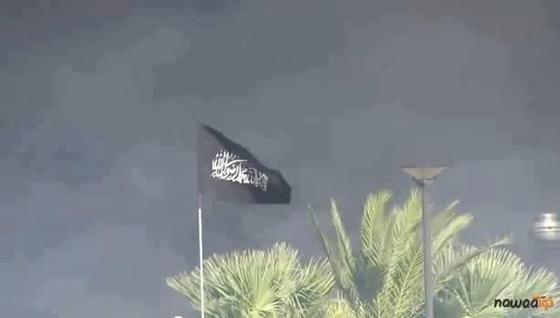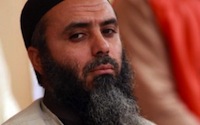 |
|
Al Qaeda’s banner flies over the US Embassy in Tunisia. Image posted on Facebook. |
On Sept. 14, the US Embassy in Tunis came under assault. The American staff evacuated the embassy unscathed, but the attackers hoisted an al Qaeda-style black flag high above the emptied compound and ransacked American property.
The embassy siege eventually led to a tense standoff at the El Fateh mosque in Tunis, after the man suspected of leading the embassy attack gave a rousing speech to his followers inside. That man is Seifallah ben Hassine, otherwise known as Abu Iyad al Tunisi.
Hassine has long worked with and for al Qaeda. After fleeing Tunisia in the 1990s, Hassine ended up in the UK, where he studied under Abu Qatada, a well-known al Qaeda cleric. Like so many other international jihadists, Hassine made his way to the Taliban’s Afghanistan, weaving a web of connections to nefarious actors across the globe.
Hassine has not denied his longstanding relationship with al Qaeda, according to press accounts.
|
|
|
Seifallah ben Hassine |
Today, Hassine leads Ansar al Sharia Tunisia, a radical Salafist group with at least hundreds of followers. The group’s muscle is enough to challenge the Tunisian government’s authority. Even though the El Fateh mosque was surrounded by government personnel, dozens of Hassine loyalists escorted him out of the building.
Hassine evaded capture and remains at large.
Ansar al Sharia
The rise of Ansar al Sharia Tunisia, as well as groups with the same brand name in other countries, presents a new challenge to the US and its allies. In other countries, such as Yemen, the ties between the Ansar al Sharia chapter and al Qaeda are clear. The emir of al Qaeda in the Arabian Peninsula (AQAP) is Nasir al Wuhayshi, who also heads Ansar al Sharia Yemen.
There are multiple groups operating under the Ansar al Sharia brand in Libya, including a militia that is suspected of launching the attack on the US Consulate in Benghazi on Sept. 11. The Ansar al Sharia militia has known ties to al Qaeda, including al Qaeda in the Islamic Maghreb (AQIM). Members of AQIM were reportedly in contact with the Ansar al Sharia militia during the consulate assault. And the Ansar al Sharia militia is headed by Sufyan Ben Qumu, an ex-Guantanamo detainee who has been identified as an al Qaeda operative.
Like other Ansar al Sharia chapters elsewhere, there are good reasons to suspect that Hassine’s group in Tunisia remains connected to al Qaeda.
Longstanding ties to al Qaeda
Official documents prepared by the US government and the United Nations show that Hassine has long operated as a part of the al Qaeda network. Leaked documents prepared by Joint Task Force Guantanamo (JTF-GTMO) shed additional light on Hassine and other TCG members, highlighting their extensive connections to al Qaeda.
In 2000, Hassine became the co-founder of the Tunisian Combatant Group (TCG), which was established with help from Osama bin Laden. The relationship between the TCG and al Qaeda has been explained by the United Nations, which notes that the TCG was created “in coordination with” al Qaeda.
Hassine reportedly met with both Osama bin Laden and Ayman al Zawahiri prior to the Sept. 11, 2001 terrorist attacks. And the TCG was implicated in the Sept. 9, 2001 assassination of Northern Alliance leader Ahmed Shah Massoud, who was killed by two Tunisians pretending to be journalists.
Massoud’s assassins were given forged passports by a senior TCG member. The assassination was an integral part of al Qaeda’s Sept. 11, 2001 plot, as Massoud was a key Afghan leader opposed to the Taliban and al Qaeda. Massoud’s death, therefore, eliminated an American ally from the battlefield before the fight for Afghanistan even began.
The TCG in Europe
The TCG was founded in Afghanistan, but in a matter of months the group became a prolific source of terrorism plots in Europe. Al Qaeda used the TCG as a tentacle for plotting against Western interests.
By early 2001, the TCG was actively plotting to attack the US embassy in Rome. Italian authorities identified a convicted terrorist named Sami Ben Khemais Essid as the TCG’s ringleader for the plot. According to the State Department’s 2001 Patterns of Global Terrorism, Essid “spent two years in Afghanistan and trained as a recruiter for al Qaeda.” Italian authorities concluded that Ben Khemais “headed al Qaeda operations in Italy” and “owned a firm that was a front for his recruitment activity and terrorist-attack planning.”
The Islamic Cultural Institute (ICI) in Milan, which was shut down by authorities, became a hub for the Ben Khamais-led TCG network in Europe. The ICI, according to the State Department’s report, “was under surveillance months before September 11 [2001] by Italian authorities seeking evidence of arms, chemicals, and explosives.” Some especially notorious terrorists visited the ICI, including “terrorists associated with the 1993 bombing of the World Trade Center and the 1998 bombings of the US Embassies in Tanzania and Kenya, all of which were perpetrated by al Qaeda.”
Italian authorities found multiple phone calls between Sheikh Omar Abdel Rahman and suspected terrorists operating out of the ICI prior to the 1993 World Trade Center Bombing. Sheikh Rahman was subsequently convicted by a US court for his role in the attack.
A current Guantanamo detainee named Abd al Salam al Hilah attended the ICI during the peak of the TCG’s terrorist plotting. According to a leaked JTF-GTMO threat assessment, Abd al Salam al Hilah “had foreknowledge of the 1993 World Trade Center bombing, the 2000 attack on the UK Embassy in Sanaa … the 2000 attack on the USS COLE, a planned attack on the US or British Embassy in Sanaa that was to occur in October 2002, and probably the 11 September 2001 terrorist attack.”
Italian authorities wiretapped a conversation between Abd al Salam al Hilah and a senior Egyptian Islamic Jihad (EIJ) operative during the summer of 2000. Abd al Salam was in the ICI at the time. After the 9/11 attacks, investigators concluded that the recorded conversation indicated Abd al Salam knew some of the details of the plot. Italian officials heard Abd al Salam say: “Well, I am studying airplanes! If it is God’s will, I hope to bring you a window or a piece of a plane next time I see you.” [See LWJ report, Yemeni government official doubled as al Qaeda operative, leaked assessment shows.]
Hassine’s ties to Guantanamo detainees
Abd al Salam al Hilah is not the only Guantanamo detainee with ties to the TCG and the ICI. At least five current Guantanamo detainees were members of the TCG. Along with Hassine, all five were allegedly deeply involved with al Qaeda as well. The Guantanamo detainees are Ridah Bin Saleh al Yazidi (internment serial number 38), Adel Bin Ahmed Bin Ibrahim Hkiml (ISN 168), Hisham Bin Ali Bin Amor Sliti (ISN 174), Abdul Bin Mohammed Bin Abess Ourgy (ISN 502), and Lotfi Bin Ali (ISN 894).
The leaked JTF-GTMO files for these five detainees contain additional details about Hassine’s career.
Hassine was detained inside Tunisia for years, and authorities there questioned him about his relationships with the Guantanamo detainees. Hassine identified all five of the Gutananamo detainees as being present at the TCG’s founding meeting in Afghanistan in 2000.
Hassine ran a Tunisian guesthouse in Jalalabad, and the terrorists who stayed there maintained numerous ties to al Qaeda. According to intelligence contained in the JTF-GTMO files, Hassine’s TCG operatives coordinated their activities with Abu Zubaydah, a senior al Qaeda operative who also remains in detention at Guantanamo.
Even as the Taliban’s Afghanistan fell to Coalition forces in late 2001, Hassine remained loyal to al Qaeda. JTF-GTMO found that Hassine set up a fighting unit called the “Jalalabad group,” which included the Guantanamo detainees and “volunteered to defend [bin Laden] and the embattled al Qaeda fighters at Tora Bora.”
Ansar al Sharia’s roots in al Qaeda
Ansar al Sharia rose out of the Arab Spring in several countries. Despite several chapters receiving international headlines, the organizations’ precise structure, relationships to one another, and allegiance remains the subject of debate.
As the history of Ansar al Sharia in Tunisia shows, however, top leaders of the group have extensive al Qaeda pedigrees. Hassine’s role in creating the TCG, with help from al Qaeda, has profound ramifications for our understanding of recent events in Tunisia.
Hassine was arrested in 2003 in Turkey for his ties to terrorists there and in Iraq. He was imprisoned in Tunisia, after being convicted of belonging to an al Qaeda-affiliated group, until 2011. He was then freed and has already targeted American interests.









5 Comments
AQ’s expectation was these Embassy assualts would prompt an uprising?
video – attack of the American Embassy in Tunis Sept 14th 2012
http://www.youtube.com/watch?v=vg6lncQnGKw
“The group’s muscle is enough to challenge the Tunisian government’s authority. Even though the El Fateh mosque was surrounded by government personnel, dozens of Hassine loyalists escorted him out of the building.”
That’s a bit of an overstatement, the mosque was surrounded by 1000 security forces. They could have gone in and arrested him. However this would have ended in a grisly bloodbath with his supporters. Tunisia has always been a “smooth operator” compared to other countries in the larger region. The bloodbath was avoided and Abu Iyad al Tunisi was quietly arrested a few days later…
While I agree that this guy needs to be watched, he is far from being able to challenge the authority of the Tunisian government.
One need only look at the GTMO list to see how well North Africans are represented in AQ. The TCG hand in 9/11 (or, more accurately, September 9th, when Masood was assassinated) shows how much UBL relied upon and trusted them with such an important undertaking. As nebulous as the web of ties between the various factions is, in some ways it is a small, small world, as well.
till now;the americans don’t learn from their mistakes